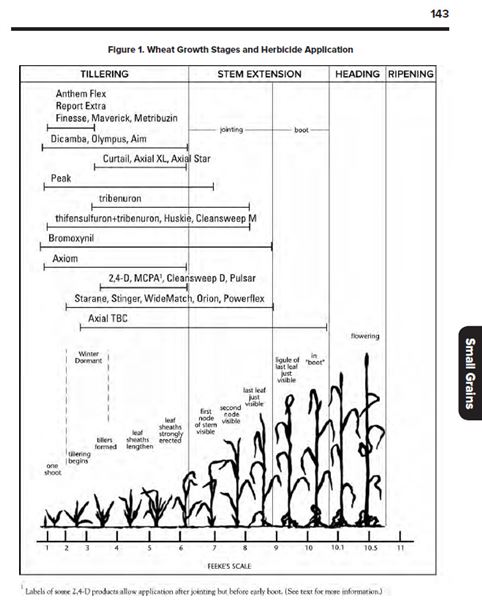Decisions About Winter Wheat And Weeds
DR. AARON HAGER
URBANA, ILL.
The most recent report on the condition of the Illinois winter wheat crop indicated approximately 10 percent of the crop was rated poor or very poor, while close to 90 percent was rated fair to excellent. It appears likely that much of the wheat crop will remain intact, but in other instances farmers might elect to terminate poorer stands and plant corn or soybean. If the decision is made to plant corn or soybean into wheat stands where some plants remain alive, it is advisable to control any remaining wheat plants prior to planting either corn or soybean. Controlling existing wheat stands may be accomplished through the use of tillage, herbicides, or a combination of these.
If the wheat field was previously treated with a herbicide, be sure to check for any applicable crop rotational intervals. These could determine whether or not corn or soybean could be planted. If a combination of herbicides and tillage will be used to terminate an existing stand, improved control might be achieved if the herbicide application occurs prior to the tillage operation, compared with the opposite order. Regardless of what herbicide you use to control wheat plants, there should be an interval of at least 3 to 5 days (or more) between application and tillage to allow the herbicide to work within the plant.
It is altogether possible that other weed species, such as maturing winter annuals, early summer annuals, biennials, or perennials, also might be present in existing wheat fields. If so, select a herbicide or herbicide combination that will provide broad-spectrum control of both grass and broadleaf weed species. If 2,4-D is included in the tankmix, be cognizant of the intervals that must elapse between application and planting (especially for soybean, but also for corn with some formulations).
Several herbicides could be used to control existing wheat plants. Glyphosate is very effective on grasses, including wheat. The label suggests using 0.56 lb ae to control overwintered wheat up to 6 inches tall, 0.77 lb ae to control wheat up to 12 inches tall, and 1.125 lb ae for wheat up to 18 inches tall. Gramoxone SL is a rapidly-acting contact herbicide. Efficacy on wheat can be improved when atrazine or metribuzin is tankmixed with Gramoxone SL. A crop oil concentrate or nonionic surfactant should be included, and thorough spray coverage is essential for good control. The labels of the ACCase-inhibiting herbicides (Poast, Assure II, Select Max, Fusilade DX, and Fusion) indicate these products are effective against volunteer wheat. However, each product label also indicates a specific rotational interval between application and planting corn. Poast is labeled for preplant applications, but applications must be made at least 30 days before planting corn. The labels of Select Max, Fusion, Fusilade DX, and Assure II indicate rotational intervals of 30, 60, 60, and 120 days, respectively, between application and planting corn.
Herbicide applications to control weeds in wheat must be properly timed to provide good weed control and minimize the potential for crop injury. Applications made to actively growing weeds and during periods of warm air temperatures generally provide more effective and complete weed control as compared with applications made during cold, cloudy conditions.
The labels of all herbicides commonly used for weed control in Illinois wheat have application restrictions based on wheat developmental stage. The majority of products commonly used in Illinois indicating applications must be made before the wheat jointing or boot stage. Figure 1 contains information derived from the herbicides labeled for use in small grains. Before making any herbicide application, consult the respective herbicide label for additional information.
If you are considering applying a herbicide with liquid nitrogen as the carrier, be sure to consult the herbicide label prior to making this type of application. Not all herbicides allow applications with liquid nitrogen as the carrier, and those that do allow this might have specific recommendations with respect to including/excluding other spray additives or their application rates. ∆
DR. AARON HAGER: Associate Professor, University of Illinois

Figure 1. Wheat growth stages and herbicide application (from 2015 Weed Control Guide for Ohio, Indiana and Illinois).